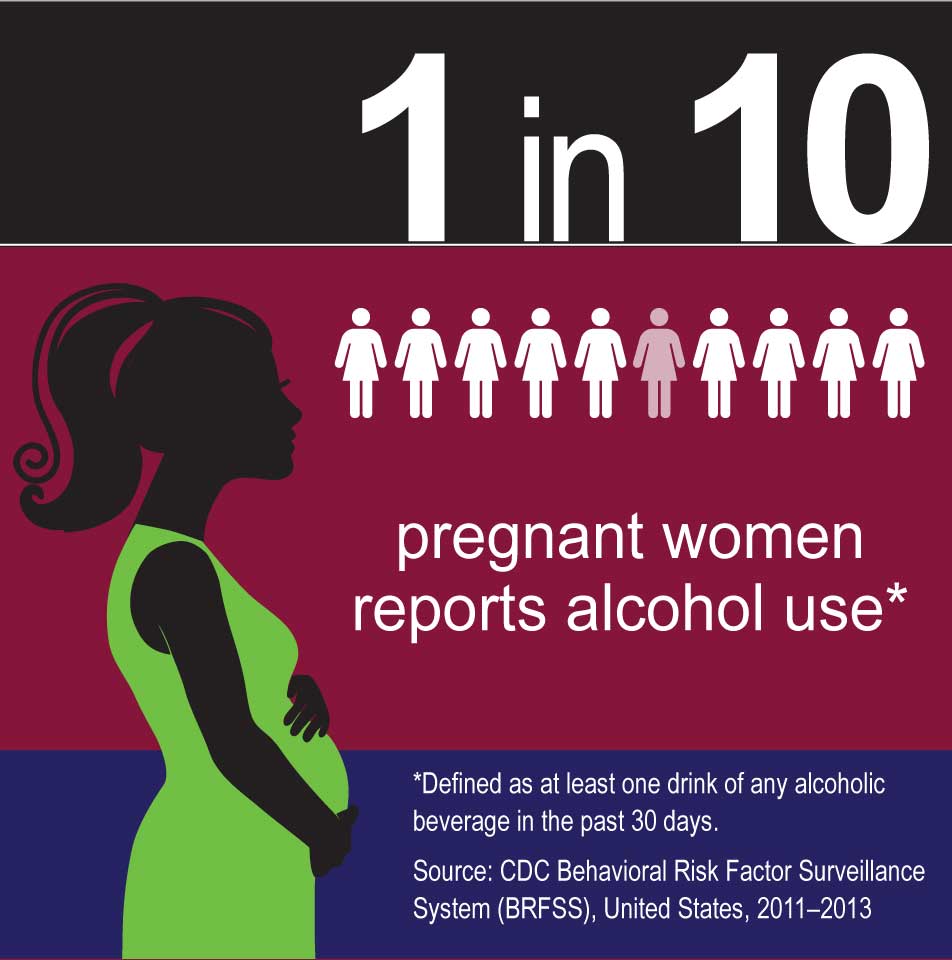Key Findings: Alcohol use and binge drinking among women of childbearing age – United States, 2011-2013
The Morbidity and Mortality Weekly Report (MMWR) has published a study looking at alcohol use among pregnant and nonpregnant women of childbearing age in the United States.
CDC researchers found that 1 in 10 pregnant women aged 18-44 years reported consuming alcohol* and about 1 in 33 reported binge drinking† in the past 30 days. This means that about one third of pregnant women who consume alcohol engage in binge drinking.
This is important information for healthcare professionals and women of childbearing age. Healthcare professionals who provide primary care to women of childbearing age should inform women that there is no known safe level of alcohol consumption when they are pregnant or might be pregnant. In addition, healthcare professionals can also implement alcohol screening and brief intervention in their primary care practices.
Main Findings
- About half of nonpregnant women reported any alcohol use* and about 1 in 5 reported binge drinking† in the past 30 days.
- Among pregnant women, 1 in 10 reported any alcohol use and 1 in 33 reported binge drinking in the past 30 days.
- Among pregnant women, the highest prevalence of any alcohol use was among those who were
- 35-44 years
- college graduates
- not married
- Among women who reported binge drinking in the past 30 days, pregnant women reported an average of 4.6 binge drinking episodes. This was higher than the average of 3.1 such episodes reported by nonpregnant women. The intensity (largest number of drinks consumed per episode) of binge drinking did not differ between pregnant and nonpregnant women.
- Among nonpregnant women who reported binge drinking, those aged 18-20 years reported the highest frequency and intensity compared to other age groups.
* Any alcohol use was defined as having at least one drink of any alcoholic beverage in the past 30 days
† Binge drinking was defined as having consumed four or more drinks on an occasion at least one time in the past 30 days.

About this Study
- The study uses data collected from the Behavioral Risk Factor Surveillance System (BRFSS), a state-based, landline and cellphone survey of the U.S. population.
- To estimate alcohol use and binge drinking for women aged 18-44 years, data from the 2011-2013 BRFSS were analyzed for all 50 states and the District of Columbia.
- Among binge drinkers, the frequency (number of binge drinking episodes in the past 30 days) and intensity (largest number of drinks consumed per episode) of binge drinking was also estimated.
CDC’s Activities: Preventing alcohol-exposed pregnancies and FASDs
CDC is working to prevent alcohol-exposed pregnancies with the following activities:
- CDC tracks alcohol use among women of reproductive age in the United States.
- CDC supports the implementation of evidence-based interventions to reduce risky alcohol use and alcohol-exposed pregnancies, including alcohol screening and brief intervention and CHOICES.
- CDC collaborates with FASD Practice and Implementation Centers and National Partners to promote systems level practice changes among healthcare providers in the prevention, identification, and management of FASDs.
- CDC promotes effective interventions to improve the lives of children, adolescents, and young adults living with FASDs and their families.
- CDC offers FASD-related educational information and materials for women of reproductive age, healthcare providers, and the general public.
More Information
- Learn more about alcohol use during pregnancy »
- More information about fetal alcohol spectrum disorders and CDC’s activities in this area »
- Learn more about alcohol screening and brief intervention and how it can be implemented in primary medical care »
Key Findings Reference
Alcohol use and binge drinking among women of childbearing age – United States, 2011–2013 Morbidity and Mortality Weekly Report; September 25, 2015; 64(37); 1042-1046 CDC
[Read Article]
Basics about Fetal Alcohol Spectrum Disorders
- Alcohol use during pregnancy can cause birth defects and developmental disabilities collectively known as fetal alcohol spectrum disorders (FASDs). It is also associated with an increased risk for other pregnancy problems, such as miscarriage, stillbirth, preterm birth, and sudden infant death syndrome (SIDS).
- There is no known safe level of alcohol use at any time during pregnancy or when trying to get pregnant. All kinds of alcohol should be avoided, including red or white wine, beer, and liquor.
- Alcohol can cause problems for a developing baby throughout pregnancy, including before a woman knows she is pregnant.
- Women who drink alcohol and do not use contraception (birth control) when they have sex might get pregnant and expose their baby to alcohol before they realize they are pregnant.
- Fetal alcohol spectrum disorders are preventable if a woman does not drink alcohol during pregnancy.